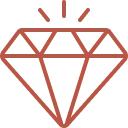
💎 Diamond Anatomy: Understanding Each Facet of a Brilliant Cut
The anatomy of a diamond—particularly the modern round brilliant cut—is a result of precise proportions, geometry, and symmetry designed to maximize light return and visual brilliance. A standard round brilliant diamond features 57 or 58 facets, depending on whether the culet is faceted or pointed. Each part of the diamond plays a crucial role in its optical performance.
1. Table
-
The largest flat facet on the top of the diamond.
-
Allows light to enter and exit the diamond.
-
Typically comprises 50–60% of the total diameter in ideal cuts.
-
Impacts both brightness and the visibility of the diamond’s interior.
2. Crown
-
The portion above the girdle, extending from the table to the girdle edge.
-
Comprised of several key facet types:
-
8 Star Facets – Triangular facets adjacent to the table.
-
8 Bezel (or Kite) Facets – Kite-shaped, between star and upper girdle facets.
-
16 Upper Girdle Facets – Located just above the girdle.
-
-
The crown height and angle affect dispersion (fire) and light refraction.
3. Girdle
-
The narrow band that separates the crown and pavilion.
-
Can be:
-
Faceted (preferred for symmetry and reflection),
-
Polished, or
-
Bruted (matte finish, older styles).
-
-
Girdle thickness is critical: too thin = prone to chipping; too thick = adds unnecessary weight.
4. Pavilion
-
The lower section below the girdle, culminating at the culet.
-
Responsible for reflecting light back through the crown.
-
Composed of:
-
8 Pavilion Main Facets – Triangle-shaped, extend from girdle to culet.
-
16 Lower Girdle Facets – Narrower facets between pavilion mains and girdle.
-
-
Pavilion depth and angle are crucial to total internal reflection.
5. Culet
-
The very bottom point of the pavilion.
-
Can be:
-
Pointed (common in modern cuts),
-
Small Facet (in antique or certain modern cuts).
-
-
A large culet appears as a visible dot when viewed through the table.
Key Optical Functions of Diamond Anatomy
-
Brilliance: White light return, heavily influenced by the crown, pavilion, and table alignment.
-
Fire: Color dispersion through crown facets.
-
Scintillation: Sparkling effect caused by light/dark facet contrast during motion.
Facet Count Breakdown (Round Brilliant)
| Facet Type | Count |
|---|---|
| Table | 1 |
| Star Facets | 8 |
| Bezel/Kite Facets | 8 |
| Upper Girdle Facets | 16 |
| Pavilion Facets | 8 |
| Lower Girdle Facets | 16 |
| Culet (optional) | 1 |
| Total | 57–58 |

